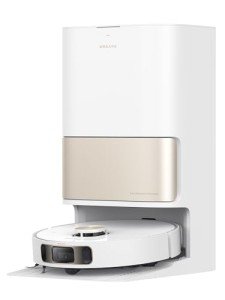The Evolution of Robot Hoovers: Revolutionizing Home Cleaning
Robot hoovers, also referred to as robotic vacuum, have actually transformed how people approach home cleaning tasks. At first presented in best robot vacuum cleaner , these autonomous makers have actually progressed rapidly due to developments in technology, expert system, and machine learning. Today, they are equipped with a variety of features that make them extremely efficient in maintaining tidiness in living spaces. This article checks out the history, functioning, advantages, and future of robot hoovers.
The History of Robot Hoovers
The principle of robotic vacuums dates back to the 1970s, however it wasn't until the launch of the Roomba by iRobot in 2002 that they gained mainstream attention. The Roomba was created to automatically navigate different surfaces, avoiding barriers while efficiently cleaning floors. Given that then, several significant developments have actually happened, including:
| Year | Development |
|---|---|
| 1996 | First model robotic vacuum cleaner developed by a Japanese company. |
| 2002 | iRobot introduces the Roomba, mass promoting robotic vacuums. |
| 2004 | Intro of the very first Roomba with a dirt detection sensing unit. |
| 2011 | Introduce of models with cordless abilities and smartphone integration. |
| 2020 | Advanced designs including AI, enhanced navigation systems, and mopping abilities. |
How Robot Hoovers Work
Robot hoovers run on a mix of sensors, video cameras, and algorithms that enable them to clean efficiently. Secret parts of these devices include:
Sensors:
- Obstacle Avoidance Sensors: Detect walls, furniture, and even stairs, preventing collisions and falls.
- Dirt Detection Sensors: Identify locations that need more extensive cleaning.
Navigation:
- Gyroscopes: Help determine the robot's orientation and movement.
- Cams and Lidar: Enable mapping of the home environment to create optimum cleaning courses.
Cleaning Mechanisms:
- Vacuum Motors: Generate suction to choose up dirt and debris.
- Brush Rollers: Agitate dirt out of carpets for much deeper cleaning.
Power Supply:
- Batteries: Rechargeable lithium-ion batteries supply the essential power for extended cleaning cycles.
User Interface:
- Mobile Apps and Smart Home Integration: Users can schedule cleanings, monitor performance, and control the robot from another location.
Benefits of Robot Hoovers
Robot hoovers provide many benefits, making them an appealing option for contemporary households:
- Time-Saving: Automated cleaning permits users to focus on other jobs while the robot effectively cleans up floorings.
- Convenience: Many models can be scheduled for cleaning sessions, guaranteeing that homes stay tidy without manual effort.
- Accessibility: Ideal for people with mobility obstacles or hectic lifestyles, enabling easier home maintenance.
- Consistent Cleaning: Regular, automated cleansings decrease the build-up of dirt and irritants, contributing to a much healthier living environment.
- Smart Technology: Integration with smart home systems allows for increased control and customization.
Limitations of Robot Hoovers
In spite of their benefits, robot hoovers feature specific limitations:
- Navigation Challenges: They might have a hard time in cluttered areas or with particular floor types such as high-pile carpets.
- Battery Life: Most models require regular charging, which can restrict cleaning duration.
- Maintenance: Regular cleaning of filters, brushes, and clearing dust bins is required for ideal performance.
- Price: Advanced models can be costly compared to traditional vacuum cleaners.
The Future of Robot Hoovers
As innovation continues to develop, the future of robot hoovers looks promising. Anticipated improvements include:
- Improved AI: Enhanced algorithms will allow for better object recognition and dynamic mapping of areas.
- Hybrid Models: Integration of vacuuming and mopping capabilities in one gadget will supply a thorough cleaning solution.
- Increased Autonomy: Future models might browse even the most complex environments without human intervention.
- Sustainability: Battery innovation developments will cause longer-lasting, more energy-efficient robots.
Often Asked Questions (FAQs)
1. Are robot hoovers reliable for family pet hair removal?
Yes, lots of robot hoovers are specifically designed to tackle animal hair with powerful suction and specialized brushes that reduce tangling.
2. How do robot hoovers browse around furniture?
Robot hoovers use a combination of sensing units and video cameras to detect challenges, permitting them to browse around furniture and avoid collisions.
3. Can robot hoovers tidy carpets?
Most modern robot hoovers are effective on both hard floors and carpets. It is a good idea to inspect the requirements of specific models for particular performance.
4. Do robot hoovers require shows?
Lots of robot hoovers feature easy to use apps that allow owners to set schedules and personalize cleaning choices, making programming uncomplicated.
5. Just how much do robot hoovers cost?
Rates for robot hoovers differ widely, ranging from ₤ 200 to around ₤ 1,500, depending upon functions and brand name.
Robot hoovers have actually come a long way because their inception, offering an effective and convenient cleaning service for modern families. best robot vacuums increasing capability and intelligence make them a useful choice for people seeking to simplify their cleaning regimens. As innovation continues to advance, robot hoovers will likely end up being much more capable, supplying extra functions that cater to the progressing requirements of users. Their journey from novelty to need highlights an essential shift in how society approaches home maintenance, marking a significant turning point in the intersection of technology and everyday life.

